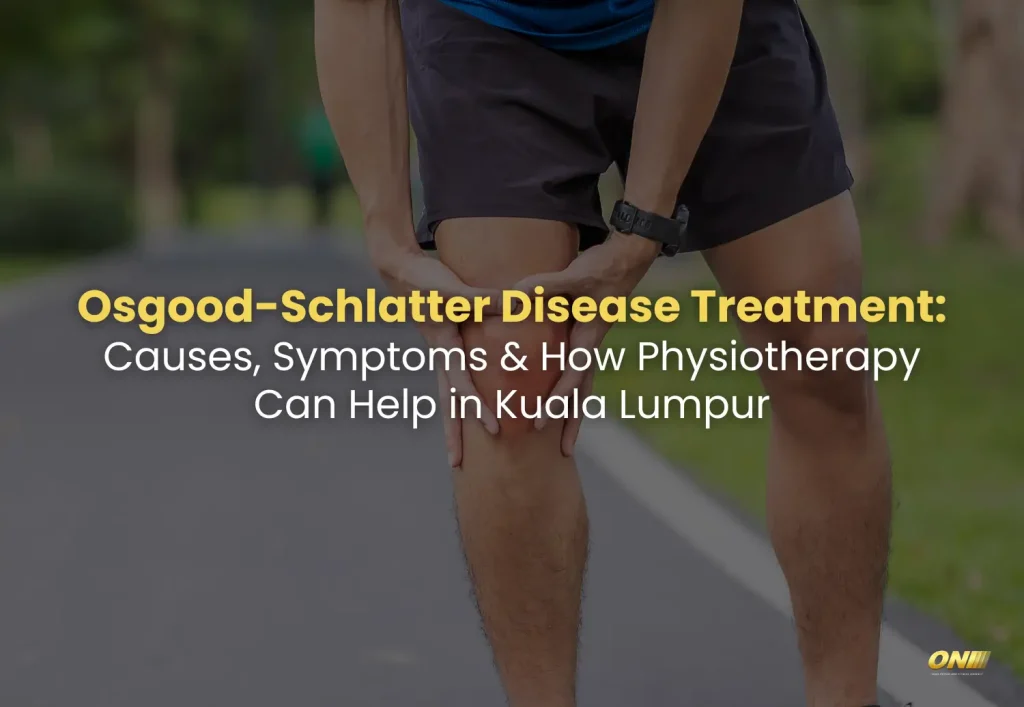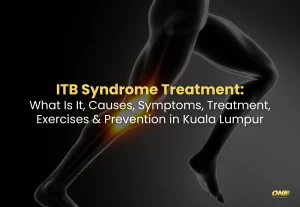Introduction
Osgood-Schlatter Disease (OSD) is a common condition that affects active children and adolescents, particularly during growth spurts. It often causes knee pain and swelling, making it difficult to participate in sports or even perform daily activities. The good news is that Osgood-Schlatter Disease can be effectively managed with the right treatment plan, including physiotherapy.
In this blog post, we’ll explore everything you need to know about OSD—what it is, its causes, symptoms, and how physiotherapy can help. If you or your child is experiencing OSD and you’re in Mont Kiara, Kuala Lumpur, or nearby areas like Sri Hartamas and Petaling Jaya, ONI Physio Fitness is here to provide expert treatment.
What Is Osgood-Schlatter Disease?

Osgood-Schlatter Disease is an overuse injury that occurs at the tibial tuberosity (the bony prominence just below the kneecap). It is caused by inflammation where the patellar tendon attaches to the shinbone.
This condition is most common in children and adolescents aged 10–15 years who are active in sports that involve running, jumping, and sudden changes in direction.
What Causes Osgood-Schlatter Disease?

Av Frank Gaillard, CC BY NC SA 3.0, via Store Medisinske Leksikon
The primary cause of OSD is repeated stress on the patellar tendon during growth spurts. Factors that contribute include:
- Rapid Growth: Bones grow faster than muscles and tendons, creating tension and stress at the attachment points.
- High-Impact Sports: Activities like basketball, soccer, and gymnastics that involve frequent running and jumping.
- Overuse: Repetitive movements can irritate the tibial tuberosity, causing inflammation.
Symptoms of Osgood-Schlatter Disease
OSD typically presents with the following symptoms:
- Pain Below the Kneecap: Pain is often localized at the tibial tuberosity and may worsen with activity.
- Swelling: Swelling or tenderness at the affected area.
- Bony Lump: A visible or palpable bump below the kneecap may develop over time.
- Reduced Range of Motion: Stiffness in the knee joint, especially after activity.
- One-Sided or Both Knees: It can affect one or both knees, depending on activity levels.
Common Populations Affected by Osgood-Schlatter Disease
- Active Children and Adolescents: Especially those involved in sports like soccer, basketball, or dance.
- Boys: Although OSD affects both genders, boys are slightly more likely to experience it.
- Growth Spurts: Children between the ages of 10 and 15 are at the highest risk due to rapid bone growth.
Osgood-Schlatter Disease Treatment
Treating OSD involves managing pain and inflammation, improving knee stability, and ensuring the condition doesn’t worsen.
1. Rest and Activity Modification
- Avoid activities that worsen the pain.
- Take short breaks from sports or high-impact activities to allow the knee to heal.
2. Ice Therapy
- Apply an ice pack to the affected area for 15–20 minutes, 2–3 times a day, to reduce swelling.
3. Physiotherapy
Physiotherapy is a cornerstone in treating OSD. At ONI Physio Fitness, our experts will:
- Develop a personalized rehabilitation plan to strengthen the quadriceps and hamstrings.
- Use manual therapy and stretching exercises to relieve tension in the patellar tendon.
- Provide guidance on safely returning to sports.
4. Knee Braces or Support
- Using knee pads or braces can help stabilize the knee during activities.
5. Pain Management
- Over-the-counter pain relievers like ibuprofen can help manage pain during flare-ups.
Exercises for Osgood-Schlatter Disease
Note: Always consult a physiotherapist before starting these exercises.
Hamstring Stretch
- Sit on the floor with one leg extended and the other bent inward.
- Lean forward from your hips, reaching toward your toes.
- Hold the stretch for 20–30 seconds and repeat 3 times per leg.
Quadriceps Stretch
- Stand upright and grab your ankle behind you.
- Pull your heel toward your buttocks until you feel a stretch in your thigh.
- Hold for 20–30 seconds and repeat 3 times per leg.
Wall Sit
- Stand with your back against a wall and slide down until your knees are at a 90-degree angle.
- Hold the position for 10–15 seconds, gradually increasing to 30 seconds.
- Repeat 5–10 times per session.
Prevention of Osgood-Schlatter Disease
Preventing OSD is all about reducing stress on the knees and maintaining flexibility:
- Stretching: Regularly stretch the quadriceps, hamstrings, and calves.
- Strength Training: Focus on building strong leg muscles to support the knee.
- Warm-Up: Always warm up before engaging in sports or physical activities.
- Proper Footwear: Use shoes with good cushioning and support.
- Listen to Your Body: Take breaks when you feel pain or discomfort to avoid overuse injuries.
Conclusion
Osgood-Schlatter Disease is a temporary yet challenging condition, especially for young athletes. With proper care, treatment, and physiotherapy, recovery is achievable without long-term complications. At ONI Physio Fitness, we specialize in helping individuals in Mont Kiara, Kuala Lumpur, and nearby areas overcome knee-related issues like OSD through tailored physiotherapy programs.
Don’t let knee pain hold you back. Book an appointment with ONI Physio Fitness today to get started on your journey to recovery!
















